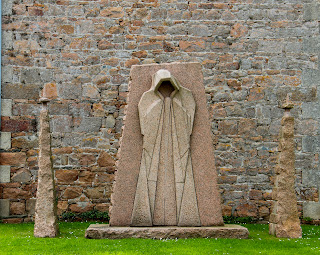Three hundred million years ago when the earth rumbled and magma flowed, hot matter bubbled up from the bowels of the earth and lay itself down to cool along the coast of Brittany. The rock that formed from that event is the loveliest pink granite, found only in a couple of places on earth. Feldspar, I think, might give it its colour. Here, the pink granite is reputed to still reach down to a depth of 5 or 6 kilometres, so, even though it is being used up rapidly, there seems to be enough of it that it is likely to be around for a long long time.
Time and tides and tumbling are slowly eroding the surface of the granite until, today, there are patches of pink to be found all along a 20 kilometre stretch of the Brittany coast close to our summer home, from huge cartoon-style menhir-like boulders of soft pink granite, down to smaller pebbles of it on the beaches, to fine grains of pink sand permeating the bays and the waterways. This stretch of coast is named after it: la cote de granit rose, or the pink granite coast.
One of the most unusual sights along the pink granite coast as, oddly, it has its back to the sea, is the Pointe du Chateau, or Castel Meur. This is a home, built as close to the water as a building can get, but facing inland to a lagoon. It looks as though it has grown organically out of two rocks, or been caught and trapped tightly between them. A house on the edge: it appears strong and immovable, yet the tenacious sea is just a few creeping metres away. Time and tides.
Further along there an exclusive little village with a tastefully expensive hotel that has an exotic tree planted in its garden at Plage St-Guirec.
Beyond the tree, and a little way along the sandy pink plage is a tiny rock Oratory dedicated to Saint Guirec, one of the mystical monks of Brittany who sailed across from Wales in order to start his monastery here in the 6th century. A little like Pol. So beloved was Guirec that by the 12th century a shrine was built here in his honour and it is maintained even today. Young women, seeking to get married, or pregnant, would make a pilgrimage to this spot and tweak Guirec's stone nose, demanding his intercession and prayers. Saint Guirec's nose has now completely worn away. Poor Guirec. Such are the trials of sainthood.
Over the point and down onto Tregastel Plage the granite rocks are giant, even theme-park in their monstrosity.
A stunning statue in the local church is tinged pink.
Children over the decades have found names for the odd rock shapes along the coast: the pile of crepes, the skull, the great chasm, and the dice.
Even the summer beach cafe is decorated to maximise the pink theme.








.jpg)






































